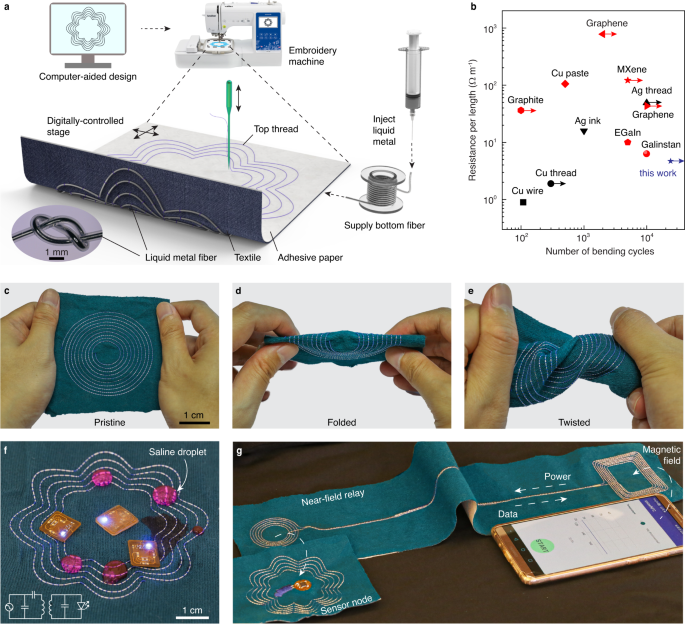Science
Related: About this forumDigitally-embroidered liquid metal electronic textiles for wearable wireless systems
Published: 21 April 2022
Rongzhou Lin, Han-Joon Kim, Sippanat Achavananthadith, Ze Xiong, Jason K. W. Lee, Yong Lin Kong & John S. Ho
Nature Communications volume 13, Article number: 2190 (2022)
Abstract
Electronic textiles capable of sensing, powering, and communication can be used to non-intrusively monitor human health during daily life. However, achieving these functionalities with clothing is challenging because of limitations in the electronic performance, flexibility and robustness of the underlying materials, which must endure repeated mechanical, thermal and chemical stresses during daily use. Here, we demonstrate electronic textile systems with functionalities in near-field powering and communication created by digital embroidery of liquid metal fibers. Owing to the unique electrical and mechanical properties of the liquid metal fibers, these electronic textiles can conform to body surfaces and establish robust wireless connectivity with nearby wearable or implantable devices, even during strenuous exercise. By transferring optimized electromagnetic patterns onto clothing in this way, we demonstrate a washable electronic shirt that can be wirelessly powered by a smartphone and continuously monitor axillary temperature without interfering with daily activities.
Introduction
Electronic textiles provide an attractive approach to seamlessly interface digital technology with the human body. By leveraging our inherent needs in clothing, electronic textiles can obviate the intrusiveness and risk often associated with implantable or epidermal electronics. In order for such clothing to function autonomously, textiles with a variety of technological capabilities are needed, including the ability to sense physiological signals, harvest energy, and wirelessly communicate data without causing discomfort or interfering with the user’s daily activities1,2,3,4,5,6. Such clothing can be used to establish a network of sensors, actuators, and displays around the body for applications ranging from health monitoring to human–computer interfaces7. However, achieving a seamless integration of electronics with clothing materials remains challenging. In contrast to the rigid and planar nature of conventionally manufactured electronics, textile is a porous structure composed of flexible materials that need to endure repeated mechanical, thermal and chemical stresses from daily activities as well as washing processes.
A broad range of innovative approaches has been explored to circumvent the inherent materials and geometrical incompatibilities. For example, button-sized electronics that integrate sensors, batteries, and wireless communication components that can directly attached to existing clothing have been developed8,9. Nevertheless, the functionalities, performance, and sensing opportunities available to such devices are constrained by the button-size footprint10. Textile functional system can be fabricated by printing/coating functional material such as conductive fillers into porous structure of the substrate textiles2,11,12. However, due to the mechanical mismatch, these approaches are prone to failures such as cracks and delamination. The infiltration also leads to discomfort, caused by the stiffening of the textile materials and blockage of porous structure that is needed for the transport of moisture and air. Hybrid strategies that combine both miniature electronic modules with large-area textile sensors can address the respective limitations of each approach13,14, but require solutions for powering and communication that do not intrude on daily activities.
Conductive threads can be digitally embroidered into clothing for wireless powering and communication using established computer-controlled textile manufacturing15,16. The seamless translation from digital design to fabrication can enable textiles with accurate reproduction of optimized wireless functional patterns17,18. Further, unlike coating and printing processes, the embroidered conductive threads can preserve the flexibility and permeability of the textile and leverage the existing manufacturing processes for scalable production. However, existing textile conductive materials have an inherent trade-off between mechanical and electrical performance. For example, metal-based threads have low resistance per length (up to 2 Ω m−1) but also have a low yield strain (0.3% for copper), rendering it fragile under repeated bending19,20,21,22,23. Alternatively, carbon-based threads with elastic limits >5% strain have been developed, but currently have high resistance per length (>100 Ω m−1) that do not meet requirements for antennas and other radio-frequency components essential for wireless connectivity24,25,26.
. . .

More:
https://www.nature.com/articles/s41467-022-29859-4